15+ Best Keyword Research Ideas: Get More Traffic in 2023
Keyword research is a vital part of content creation, and there are various keyword research ideas that can fuel a content creation engine. Some of these ideas are often overlooked, but they can be just as important as the more popular ones. Additionally, incorporating modern keyword research ideas into your content strategy can provide you with a competitive edge.
In this article, I’ll help you discover new and innovative content ideas for your business. These tips will help guide you to build a stronger brand, increase traffic and leads, improve SEO, educate your audience, increase engagement, stay ahead of the competition, and generate more sales.
We’ll explore the best keyword research ideas to help you find new and relevant content ideas for your business.
Let’s take a look.
What Are The Best Keyword Research Ideas For 2023?
Here are the top 21 keyword research ideas you can use to jumpstart your business.
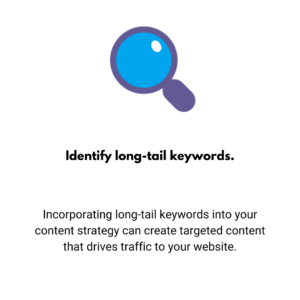
1. Identify long-tail keywords.
Long-tail keywords are specific and longer phrases that are highly relevant to your niche or topic.
They can attract a focused audience, generate significant traffic, and have less competition.
Incorporating long-tail keywords into your content strategy can create targeted content that drives traffic to your website.

2. Use keyword research tools.
Keyword research tools, such as Google Keyword Planner, Ahrefs, SEMrush, and Moz Keyword Explorer, offer insights into search volume, competition, and related keywords.
They help you optimize your content for search engines, find new keyword ideas, and create content that meets your audience’s needs.

3. Analyze competitor keywords.
Analyzing your competitor’s website can reveal what content and keyword strategy works for them, providing insights into what resonates with your shared target audience.
You can use this information to identify content gaps and create more valuable content. Additionally, analyzing their backlinks can identify link building opportunities.
This helps you develop a more effective content and keyword strategy for your business.

4. Use Google Suggest.
Google’s autocomplete feature offers real-time search suggestions that can inform keyword research.
By paying attention to these suggestions, you can identify relevant keywords and topics, optimize your content, and gain insights into related searches.
This can help you create content that resonates with your audience and ranks well in search results.

5. Use social media to find trending topics.
Social media provides insights into popular topics and keywords for your target audience.
Monitoring hashtags and conversations helps you identify new content ideas and optimize your content for your audience.
This allows you to create more valuable content that engages your audience and stays current with trends.
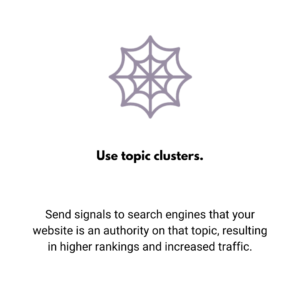
6. Use topic clusters.
Topic clusters group related topics together to create a comprehensive resource for a specific theme or topic.
This strategy signals to search engines that your website is an authority on that topic, resulting in higher rankings and increased traffic.
Clustering also creates a better user experience, leading to more engagement and time spent on your site.
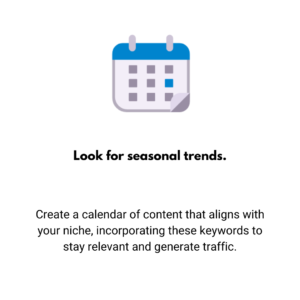
7. Look for seasonal trends.
Seasonal keywords are popular search terms during specific times of the year, providing an opportunity to generate more traffic.
Creating seasonal content engages your audience and anticipates their interests.
By planning ahead, you can create a calendar of content that aligns with your niche, incorporating these keywords to stay relevant and generate traffic.

8. Focus on informational keywords.
Transactional keywords indicate buying intent, while informational keywords answer questions and solve problems.
Targeting only transactional keywords limits content reach while targeting both educates the audience, establishes authority, and builds trust.
Incorporating a mix of transactional and informational keywords creates a well-rounded content strategy that targets all stages of the buyer’s journey.
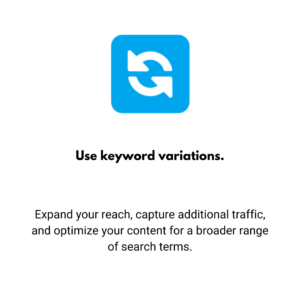
9. Use keyword variations.
Using keyword variations captures a wider audience as people search for the same thing in different ways.
It avoids keyword stuffing, is optimized for search engines, and provides a natural and engaging experience.
This expands your reach, captures additional traffic, and optimizes your content for a broader range of search terms.
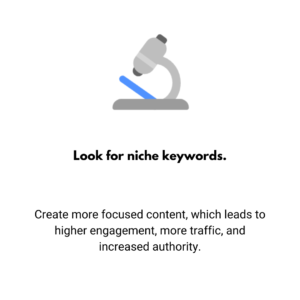
10. Look for niche keywords.
Targeting long-tail keywords specific to a niche generates more targeted traffic by catering to unique audience interests.
Niches often have less competition, allowing easier search result ranking.
Incorporating niche keywords creates more focused content, leading to higher engagement, more traffic, and increased authority.
It’s a powerful way to build a stronger presence in your industry.
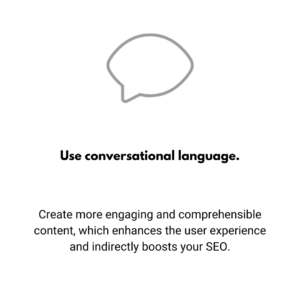
11. Use conversational language.
Utilizing conversational language in keyword research is key in matching how users naturally search, particularly with the rise of voice search.
It helps with identifying long-tail keywords and understanding user intent more accurately, given that spoken search queries often provide more context than traditional text searches.
Also, a conversational tone tends to create more engaging and comprehensible content, enhancing user experience and indirectly boosting SEO, which can lead to improved search rankings and increased organic traffic.
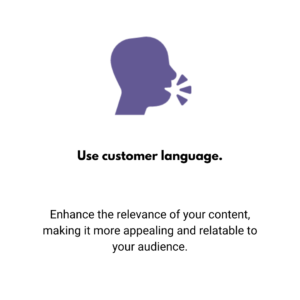
12. Use customer language.
Using customer language in keyword research is about mirroring the terms and phrases your audience uses.
This approach helps ensure that your content aligns with the actual search terms used by customers, improving the chances of your content appearing in their search results.
It enhances the relevance of your content, making it more appealing and relatable to your audience.
This not only improves your SEO but also increases engagement, builds trust with your audience, and ultimately drives more conversions.
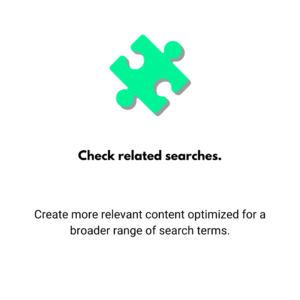
13. Check related searches.
Review the “related searches” section at the bottom of a Google search results page for ideas on related keywords and topics to target.
Incorporating them creates more relevant content optimized for a broader range of search terms.
Targeting related searches increases content visibility, attracting more traffic.
It’s a valuable tool to inform a more effective content strategy.

14. Use negative keywords.
Negative keywords exclude irrelevant words or phrases from your content, avoiding wasted advertising budget and refining targeting.
It improves the relevance and quality score of your ads, resulting in higher rankings and lower costs per click.
It can be identified through keyword research and analyzed search terms.
Regularly reviewing and refining negative keywords ensures that your content reaches the most relevant and interested users, improving engagement and conversions.
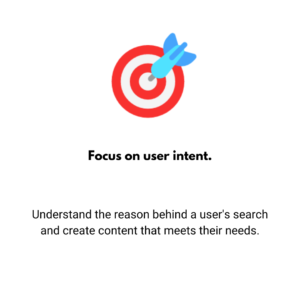
15. Focus on user intent.
Rather than just targeting keywords, focus on user intent.
This means understanding the reason behind a user’s search query and creating content that meets their needs.
For example, if someone searches for “how to fix a leaky faucet,” the intent is to find a solution to a problem, so your content should provide a clear and actionable answer.

16. Use semantic SEO.
Semantic SEO uses related concepts and entities to make your content more comprehensive and valuable to your audience, beyond just targeting keywords.
By incorporating related concepts, it helps your content rank higher in search results, improve engagement and drive more traffic.
It requires a deep understanding of your audience’s interests and the broader context of their search queries.
By leveraging related concepts, it creates valuable and engaging content that meets the needs and interests of your target audience.
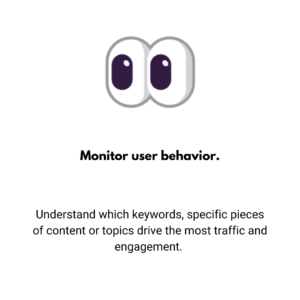
17. Monitor user behavior.
Monitoring user behavior on your website reveals which keywords and topics drive traffic and engagement.
Analyzing this data helps you optimize your content and keyword strategy and identify emerging trends and interests.
It also identifies areas for website improvements, such as reducing bounce rates.
Understanding what resonates with your audience helps you create compelling content that generates leads, conversions, and revenue.

18. Monitor trends and news.
Staying up-to-date on industry trends and news helps you identify new topics and keywords to target.
Use Google Trends to track the search volume for keywords and stay ahead of the curve.
Also, keep an eye on what your competitors rank for to identify new trends or opportunities to improve your own content and keyword strategy.
By doing this, you can create targeted and relevant content that ranks well in search results, maintaining your competitive edge.

19. Use visual search optimization.
Visual search is becoming more common, so it’s important to optimize your content for image search queries.
Visual Search Optimization is about making your images more discoverable and understandable for search engines.
By properly tagging, naming, and describing your images, as well as using structured data and implementing image sitemaps, you’re providing critical information that search engines can use to index your images.
This increases the likelihood that your images will appear in the image search results, which can drive more traffic to your site. Also, optimizing for image search can enhance the user experience, particularly for users who prefer or rely on visual information, which can lead to higher engagement and conversions.
What Are The Benefits Of Finding New Content Ideas?
There are many benefits to finding new content ideas in business, including:
1. Build a Stronger Brand.
Consistently create valuable and relevant content to build a stronger brand and establish yourself as an authority in your industry.
2. Increase Traffic and Leads.
Target the right keywords and create content that answers your audience’s questions and solves their problems. You can drive more traffic to your website and generate more leads.
3. Improve SEO.
Incorporate relevant keywords and create high-quality content to improve your search engine rankings and increase your visibility on search engines.
4. Educating Your Audience.
Create educational and informative content to help your audience understand your products or services and make informed decisions.
5. Increase Engagement.
Create engaging and interactive content to increase engagement with your audience and build a stronger relationship with them.
6. Stay Ahead of the Competition.
Regularly create new and innovative content to stay ahead of your competition and establish yourself as a thought leader in your industry.
7. Generate More Sales.
Creating content that speaks to your audience’s pain points helps to offer solutions to their problems, so you can generate more sales and increase your revenue.
Summary
Keyword research is a critical component of content creation that can generate traffic to your website and improve your search engine rankings. By implementing various keyword research ideas, including overlooked and modern ones, you can develop relevant and targeted content that is more likely to rank well in search results. This can result in benefits such as building a stronger brand, increasing traffic and leads, improving SEO, educating your audience, increasing engagement, staying ahead of the competition, and generating more sales. In short, finding new content ideas in business is essential for a successful content marketing strategy.
Further Reading: